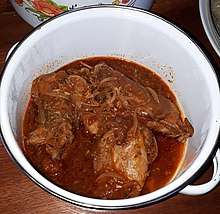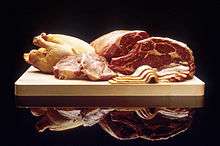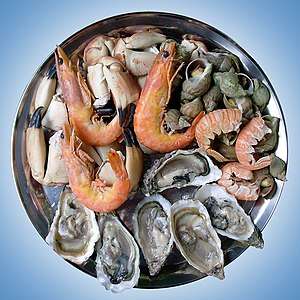Cat meat
Cat meat is meat prepared from domestic cats for human consumption. Some countries eat cat meat regularly, whereas others have only consumed some cat meat in desperation during wartime or poverty.

| Part of a series on |
| Animal rights |
|---|
|
|
Ideas |
|
Related |
|
|
Africa
Prehistoric human feces have contained bones from the wild cat of Africa.[1]
In some cultures of Cameroon, there is a special ceremony featuring cat-eating that is thought to bring good luck.[2]
Asia
China
In Guangdong and Guangxi provinces in south-eastern China, some—especially older—people consider cat flesh a good warming food during winter months. It is estimated that in southern China's Guangdong province (population just over 113 million) people eat 10,000 cats per day.[3][4]
In Guangdong, cat meat is a main ingredient in the traditional dish "dragon, tiger, phoenix" (snake, cat, chicken), which is said to fortify the body.[5]
Organized cat-collectors supply the southern restaurants with animals that often originate in Anhui and Jiangsu provinces.[5][6][7] On 26 January 2010, China launched its first draft proposal to protect the country's animals from maltreatment including a measure to jail people—for periods up to 15 days—for eating cat or dog meat.[8][9]
With the increase of cats as pets in China, opposition towards the traditional use of cats for food has grown. In June 2006, approximately 40 activists stormed the Fangji Cat Meatball Restaurant in Shenzhen, forcing it to shut down.[10] Expanded to more than 40 member societies, the Chinese Animal Protection Network in January 2006 began organizing well-publicized protests against dog and cat consumption, starting in Guangzhou, following up in more than ten other cities "with very optimal response from public."[11]
Japan
In Japan, cat meat was consumed until the end of the Tokugawa period in the 19th century.[12]
Korea
In Korea, cat meat was historically brewed into a tonic as a folk remedy for neuralgia and arthritis, not commonly as food. Modern consumption is rare and more likely to be in the form of cat soup.[13][14][15]
Taiwan
In October 2017, Taiwan's national legislature, known as Legislative Yuan, passed amendments to the country's Animal Protection Act which "bans the sale and consumption of dog and cat meat and of any food products that contain the meat or other parts of these animals."[16]
Vietnam
As of 2015, cat meat is eaten in Vietnam, even though it is technically illegal.[17][18][19][20][21][22][23] It is generally seen on menus with the euphemism "tiểu hổ", literally "baby tiger" rather than the literal "thịt mèo". Cat galls have aphrodisiacal properties according to people in North Vietnam.[24][25] In 2018, however, officials in the city of Hanoi urged citizens to stop eating dog and cat meat, citing concerns about the cruel methods with which the animals are slaughtered and the diseases this practice propagates, including rabies and leptospirosis. The primary reason for this exhortation seems to be a fear that the practice of dog and cat consumption, most of which are stolen household pets, could tarnish the city's image as a "civilised and modern capital".[26] According to data from a market research study by Four Paws, approximately 8% of people living in Hanoi have consumed cat meat in their lives.[27]
Europe
Switzerland
According to the Food Safety and Veterinary Office, the sale of dog or cat meat is not allowed, but it is legal for people to eat their own animals. The Swiss parliament rejected changing the laws to protect dogs and cats for human consumption in 1993.
Denmark
In June 2008, three students at the Danish School of Media and Journalism published pictures of a cat being slaughtered and eaten in Citat, a magazine for journalism students. Their goal was to create a debate about animal welfare. The cat was shot by its owner, a farmer, and it would have been put down in any case. The farmer slaughtered the cat within the limits of Danish law. This led to criticism from Danish animal welfare group Dyrenes Beskyttelse,[28][29] and death threats received by the students.[30]
United Kingdom
In 18th-century Britain, there are a few records of cats being eaten as a form of entertainment.[31]
Italy
In February 2010, on a television cooking show, the Italian food writer Beppe Bigazzi mentioned that during the famine in World War II cat stew was a "succulent" and well-known dish in his home area of Valdarno, Tuscany. Later he claimed he had been joking, but added that cats used to be eaten in the area during famine periods, historically. He was widely criticised in the media for his comments and ultimately dropped from the television network.[32]
Cat consumption is a stereotype attributed to Vincenzans in Vicenza, Italy.[33]
According to the British Butchers' Advocate, Dressed Poultry and the Food Merchant of 1904, "Just before Christmas it is common for a group of young men in northern Italy to kill some cats, skin them and soak them in water for two or three days. They are cooked with great care on Christmas day and served up hot about 1.30 P. M., after mass....Many people in Italy, 'on the quiet,' keep cats like the English do rabbits—to kill. A catskin there is worth ten pence, as the material for muffs for girls... Extraordinary care has to be taken in procuring the animals, for the Italian Society for the Protection of Cats is vigilant, and offenses against the law are followed by imprisonment only. We have no fines in Italy."[34]
According to The Dietetic & Hygienic Gazette in 1905, "Italy cultivates the cat for home consumption as English people raise rabbits. It is to be done on the quiet, however, for in spite of the profit in the business and the demand for the delicacy, the law has to be looked out for, and the Society for the Prevention of Cruelty to Cats is vigilant. Offenses against the law are visited with imprisonment. Cats are raised for the market nonetheless. Fattened on the finest of milk, a choice specimen will attain the weight of fifteen pounds."[35][36]
France and Spain
There are accounts of cat being consumed in the Roman province of Gallia Narbonensis (southern France), in Spain in the 17th century, and during WWI and WWII.[33]
Other Areas
Cats were sometimes eaten as a famine food during harsh winters, poor harvests, and wartime. Cat gained notoriety as "roof rabbit" in Central Europe's hard times during and between World War I and World War II.[37]
Oceania
Australia
Indigenous Australians in the area of Alice Springs roast feral cats on an open fire. They have also developed recipes for cat stew. Some other inhabitants of the area have also taken up this custom, justified on the grounds that felines are "a serious threat to Australia's native fauna". Scientists warned that eating wild cats could expose humans to harmful bacteria and toxins.[38]
The Americas
Peru
Cat is not a regular menu item in Peru, but is used in such dishes as fricassee and stews most abundant in two specific sites in the country: the southern town of Chincha Alta (Ica Region, Afro-Peruvian mostly) and the north-central Andean town of Huari (Ancash Region). Primarily used by Afro-Peruvians. Cat cooking techniques are demonstrated every September during the festival of Saint Efigenia in a town of La Quebrada.[39]
In October 2013, a judge banned the annual El Festival Gastronomico del Gato (the Gastronomic Festival of the Cat), which was held every September in La Quebrada to commemorate the arrival of settlers who were forced to eat cats to survive, citing it as cruel to the 100+ cats specifically bred for the event, which involves being kept in cages for a year prior the Festival. The judge also cited concerns over the safety of the meat, which drew criticism from residents who contend that cat meat is far richer than rabbit or duck, and that it has been long consumed globally without any deleterious effects.[40]
That same month, magistrate Maria Luyo banned the festival of Curruñao in the small town of San Luis. Locals say that the festival, which sees cats being drowned, skinned and tied to fireworks and blown up, dates back to the practice of eating cat on the part of African slaves who worked on sugar-cane plantations in colonial times, and is part of the religious celebrations of Santa Efigenia, an African-Peruvian folk saint. Luyo stated in her ruling that the festival "fomented violence based on cruel acts against animals which caused grave social damage and damaged public health", and that minors could be "psychologically damaged" by watching the events.[41]
The United States
In December of 2018, the Dog and Cat Meat Trade Prohibition Act of 2018 was signed into federal law making the consumption of cat meat illegal and punishable by a fine of $5000, except as part of Native American religious ceremonies. Previous to that bill, consuming cat meat was technically legal in 44 states.[42]
Jewish and Islamic tradition
The Jewish laws of kashrut and Islamic dietary laws both forbid the consumption of cat meat.[43] Kashrut and Halal Laws both disallow the consumption of any terrestrial predators. To be considered kosher in the case of mammals, it must not be a predator and it must both chew cud and have cloven hooves.[44][45]
See also
- Dog meat
- Horse meat
- List of meat animals
- Taboo food and drink
References
- David Taylor; Daphne Negus; Dave King; Jane Burton (1989). The Ultimate Cat Book. Simon and Schuster. pp. 9–. ISBN 978-0-671-68649-9.
- Ngwa-Niba, Francis (2003-03-17). "The cat eaters of Cameroon". BBC News.
- "China Protesters: Stop 'Cooking Cats Alive' – Fury After Newspaper Says 10,000 Felines Are Eaten Daily in Single Province". NBC News. Associated Press. 18 December 2008.
- "Trying to get cat off the menu in China". The Star. 26 July 2009.
- Some call it an indelicate trade, others, a delicacy Archived 2017-03-14 at the Wayback Machine, Xinhuanet.com, 13 Jan 2012 (from China Daily)
- Wang, Yu (2008-12-19). "Nanjing sends meat that meows to Guangzhou". Beijing: Beijing Today. Archived from the original on 2014-02-24. Retrieved 2014-02-20.
- Moore, Malcolm (2009-01-01). "Cat-nappers feed Cantonese taste for pet delicacy". London: Telegraph.
- "China to jail people for up to 15 days who eat dog". Chinadaily. Retrieved 2010-01-26.
- "Trung Quốc sắp sửa cấm ăn thịt chó, mèo". (in Vietnamese)
- "Animal rights protest shuts restaurant". Reuters. Archived from the original on 2006-07-13. Retrieved 2006-10-22.
- "Guangzhou bans eating snakes--ban helps cats". Reuters via animalpeoplenews.org. Archived from the original on 2008-03-04. Retrieved 2008-02-16.
- Hanley, Susan (1997). Everyday Things in Premodern Japan. p. 66.
- "Dog and Cat Meat Consumption – In Defense of Animals – In Defense of Animals". In Defense of Animals. Archived from the original on 23 November 2015. Retrieved 22 November 2015.
- "Ban South Korean dog and cat meat trade". Our Compass. Retrieved 22 November 2015.
- "Important Update On South Korean Dog And Cat Meat Trade". Retrieved 22 November 2015.
- Zeldin, Wendy (October 18, 2017). "Taiwan: Animal Protection Law Amended | Global Legal Monitor". www.loc.gov.
- Việt Báo Thịt mèo
- "Thành phố thịt mèo". Archived from the original on 2013-05-21. Retrieved 2016-05-01.
- "9 Countries That Eat Cats and Dogs". The Daily Meal. Archived from the original on 23 November 2015. Retrieved 22 November 2015.
- "Cat Meat". Vietnam Coracle. Archived from the original on 23 November 2015. Retrieved 22 November 2015.
- "The Truth About Cats & Dogs In Vietnam - The Dropout Diaries". The Dropout Diaries. Archived from the original on 23 November 2015. Retrieved 22 November 2015.
- "Where cat sits happily on the menu". Stuff. Retrieved 22 November 2015.
- The Christian Science Monitor. "Why do Vietnamese keep cats on a leash? (Hint: What's for dinner?)". The Christian Science Monitor. Retrieved 22 November 2015.
- Jerry Hopkins (15 May 2004). Extreme Cuisine: The Weird and Wonderful Foods That People Eat. Tuttle Publishing. pp. 25–. ISBN 978-1-4629-0472-3.
- Jerry Hopkins (23 December 2014). Strange Foods. Tuttle Publishing. pp. 8–. ISBN 978-1-4629-1676-4.
- "Vietnamese capital Hanoi asks people not to eat dog meat". BBC News. 12 September 2018. Retrieved 16 April 2020.
- The Dog and Cat Meat Trade in Southeast Asia: A Threat to Animals and People Harvard Kennedy School, February 2020 (PDF; Page 16)
- Walsh, Kevin (2008-06-05). "Journalistelever spiser kat" [Journalism students eat cat]. BT (in Danish). Berlingske Media. Retrieved 2013-10-28.
- Andreassen, Andreas Marckmann (2008-06-06). "Journaliststuderende spiser kat på nettet" [Journalism students eat cat online]. Journalisten.dk (in Danish). Journalisten. Retrieved 2013-10-28.
- Helmer, Jesper (2008-06-07). "Århus-studerende spiste kat - nu trues de på livet" [Students from Århus ate cat - are now threatened on their life]. Avisen.dk (in Danish). Avisen.dk ApS. Retrieved 2013-10-28.
- "The Cat Eaters". forteantimes.com. Archived from the original on 2009-05-21. Retrieved 2009-10-12.
- Owen, Richard (February 16, 2010). "Celebrity chef Beppe Bigazzi upsets viewers with his cat casserole". London: The Times.
- Ken Albala (2003). Food in Early Modern Europe. Greenwood Publishing Group. pp. 66–. ISBN 978-0-313-31962-4.
- Butchers' Advocate, Dressed Poultry and the Food Merchant. 1904. pp. 11–.
- The Dietetic & Hygienic Gazette. Gazette Publishing Company. 1905. pp. 99–100.
- Dietetic and Hygienic Gazette. Gazette Publishing Company. 1905. pp. 99–100.
- "Cats - Friend Or Food". Messybeast.com. Retrieved 2010-06-14.
- Mercer, Phil (2007-09-02). "Australians cook up wild cat stew". BBC News.
- "'Cat-eaters' take note - feline feast at Peru festival". planetark.com. Archived from the original on 2004-09-11. Retrieved 2008-02-16.
- Golgowksi, Nina (October 15, 2013). "Judge bans Peruvian town's annual cat-eating festival". Daily News (New York).
- Collyns, Dan (October 18, 2013). "Claws out as Peruvian judge suspends annual cat race and feast". The Guardian.
- Press, The Associated. "President Trump signs the Farm Bill making dog and cat meat illegal in the United States". www.wrdw.com. Retrieved 2018-12-27.
- Sahih Muslim, 21:4752
- Rabbi Louis Jacobs (2014-01-31). "Kosher Animals". My Jewish Learning. Retrieved 2017-09-15.
- "Judaism 101: Kashrut: Jewish Dietary Laws". Jewfaq.org. Retrieved 2017-09-15.
External links
| Wikimedia Commons has media related to Cats as food. |

